 W
WAn air-line railroad was a railroad that was relatively flat and straight, choosing a shorter route over an easier route. In their heyday, which was prior to aviation, they were often referred to simply as "air lines". For example, a 1903 novel indicates a character's success by noting his position as "superintendent of passenger traffic of the New York and Chicago Air Line", a fictitious railroad.
 W
WIn transportation infrastructure, a bidirectional traffic system divides travellers into two streams of traffic that flow in opposite directions.
 W
WIn civil engineering, a cut or cutting is where soil or rock from a relative rise along a route is removed. The term is also used in river management to speed a waterway's flow by short-cutting a meander.
 W
WIn earthmoving, cut and fill is the process of constructing a railway, road or canal whereby the amount of material from cuts roughly matches the amount of fill needed to make nearby embankments, so minimizing the amount of construction labor.
 W
WIn civil engineering, a cut or cutting is where soil or rock from a relative rise along a route is removed. The term is also used in river management to speed a waterway's flow by short-cutting a meander.
 W
WA derail or derailer is a device used to prevent fouling of a rail track by unauthorized movements of trains or unattended rolling stock. The device works by derailing the equipment as it rolls over or through it.
 W
WA road, railway line, or canal is normally raised onto an embankment made of compacted soil to avoid a change in level required by the terrain, the alternatives being either to have an unacceptable change in level or detour to follow a contour. A cutting is used for the same purpose where the land is originally higher than required.
 W
WIn railway signalling, an interlocking is an arrangement of signal apparatus that prevents conflicting movements through an arrangement of tracks such as junctions or crossings. The signalling appliances and tracks are sometimes collectively referred to as an interlocking plant. An interlocking is designed so that it is impossible to display a signal to proceed unless the route to be used is proven safe.
 W
WThe list of automated train systems is ordered in descending order of the degree of automation. It uses the Grade of Automation classifications specified by the standard IEC 62290‐1. These are explained diagrammatically by the UITP.
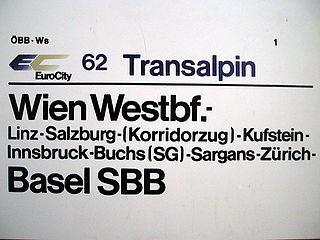 W
WPrivileged transit traffic or corridor traffic is traffic of one country across the territory of another country without usual customs and passport checks. The corresponding line of communication is called the (privileged) traffic corridor and a train used in this kind of transit is called a corridor train. The reason for such arrangements is usually border changes or border creation which cut through an existing transport corridor.
 W
WRailroad ecology or railway ecology is a term used to refer to the study of the ecological community growing along railroad or railway tracks and the effects of railroads on natural ecosystems. Such ecosystems have been studied primarily in Europe. Similar conditions and effects appear also by roads used by vehicles. Railroads along with roads, canals, and power lines are examples of linear infrastructure intrusions.
 W
WA railroad switch (AE), turnout, or [set of] points (BE) is a mechanical installation enabling railway trains to be guided from one track to another, such as at a railway junction or where a spur or siding branches off.
 W
WA railroad tie, crosstie, railway tie or railway sleeper is a rectangular support for the rails in railroad tracks. Generally laid perpendicular to the rails, ties transfer loads to the track ballast and subgrade, hold the rails upright and keep them spaced to the correct gauge.
 W
WA railway signal is a visual display device that conveys instructions or provides advance warning of instructions regarding the driver’s authority to proceed. The driver interprets the signal's indication and acts accordingly. Typically, a signal might inform the driver of the speed at which the train may safely proceed or it may instruct the driver to stop.
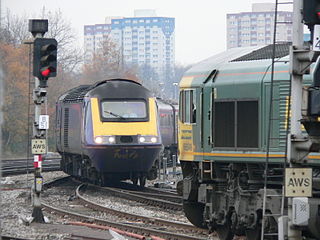 W
WRailway signalling is a system used to direct railway traffic and keep trains clear of each other at all times. Trains move on fixed rails, making them uniquely susceptible to collision. This susceptibility is exacerbated by the enormous weight and momentum of a train, which makes it difficult to quickly stop when encountering an obstacle. In the UK, the Regulation of Railways Act 1889 introduced a series of requirements on matters such as the implementation of interlocked block signalling and other safety measures as a direct result of the Armagh rail disaster in that year.
 W
WA right-of-way (ROW) is a right to make a way over a piece of land, usually to and from another piece of land. A right of way is a type of easement granted or reserved over the land for transportation purposes, such as a highway, public footpath, rail transport, canal, as well as electrical transmission lines, oil and gas pipelines. A right-of-way can be used to build a bike trail. A right-of-way is reserved for the purposes of maintenance or expansion of existing services with the right-of-way. In the case of an easement, it may revert to its original owners if the facility is abandoned. This American English term is also used to denote the land itself.
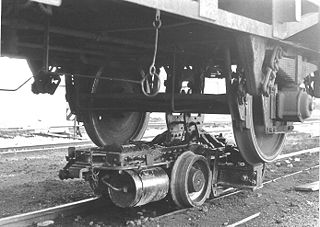 W
WRollbocks, sometimes called transporter trailers, are narrow gauge railway trucks or bogies that allow a standard gauge wagon to 'piggyback' on a narrow-gauge line. The Vevey system enables a coupled train of standard gauge wagons to be automatically loaded or rolled onto Rollbocks, so that the train can then continue through a change of gauge.
 W
WThe structure gauge, also called the minimum clearance outline, is the minimum height and width of tunnels and bridges as well as the minimum height and width of the doors that allow a rail siding access into a warehouse. In addition, the term may apply to the minimum distance to railway platforms, buildings, electrical equipment boxes, railway signal equipment, third rails or to supports for overhead lines from the track. The width of a narrow cut can also affect the maximum loading gauge.
 W
WA tell-tale, also known as a bridge warning, is a series of ropes suspended over railway tracks to give warning to the engineer, and more importantly the brakeman who may be scampering across the tops of the cars, that the train is approaching a low-clearance obstacle, such as a tunnel or a bridge. In the US, a standard tell-tale design had ropes on 3 in (7.6 cm) centers for a width of 8 ft (2.4 m) over the track, the bottom of the ropes 6 in (15 cm) lower than the height of the obstruction, and placed at least 100 ft (30 m) before the obstruction.
 W
WThe track on a railway or railroad, also known as the permanent way, is the structure consisting of the rails, fasteners, railroad ties and ballast, plus the underlying subgrade. It enables trains to move by providing a dependable surface for their wheels to roll upon. For clarity it is often referred to as railway track or railroad track. Tracks where electric trains or electric trams run are equipped with an electrification system such as an overhead electrical power line or an additional electrified rail.
 W
WTrack ballast forms the trackbed upon which railroad ties (sleepers) are laid. It is packed between, below, and around the ties. It is used to bear the load from the railroad ties, to facilitate drainage of water, and also to keep down vegetation that might interfere with the track structure. Ballast also holds the track in place as the trains roll over it. A variety of materials have been used as track ballast, including crushed stone, washed gravel, bank run (unwashed) gravel, torpedo gravel, slag, chats, coal cinders, sand, and burnt clay. The term "ballast" comes from a nautical term for the stones used to stabilize a ship.
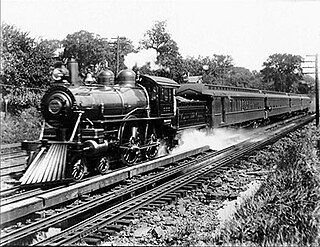 W
WA water trough, or track pan is a device to enable a steam locomotive to replenish its water supply while in motion. It consists of a long trough filled with water, lying between the rails. When a steam locomotive passes over the trough, a water scoop can be lowered, and the speed of forward motion forces water into the scoop, up the scoop pipe and into the tanks or locomotive tender.
 W
WA transport corridor is a generally linear area that is defined by one or more modes of transportation like highways, railroads or public transit which share a common course. Development often occurs around transportation corridors because they carry so many people, creating linear agglomerations like the Las Vegas Strip or the linear form of many neighborhood retail areas.
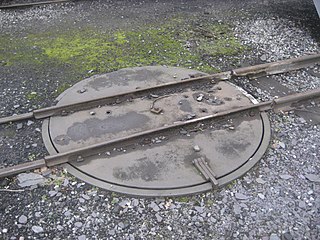 W
WIn rail terminology, a railway turntable or wheelhouse is a device for turning railway rolling stock, usually locomotives, so that they can be moved back in the direction from which they came. This is especially true in areas where economic considerations or a lack of sufficient space have served to weigh against the construction of a turnaround wye. In the case of steam locomotives, railways needed a way to turn the locomotives around for return trips as their controls were often not configured for extended periods of running in reverse and in many locomotives the top speed was lower in reverse motion. In the case of diesel locomotives, though most can be operated in either direction, they are treated as having "front ends" and "rear ends". When operated as a single unit, the railway company often prefers, or requires, that a diesel locomotive is run "front end" first. When operated as part of a multiple unit locomotive consist, the locomotives can be arranged so that the consist can be operated "front end first" no matter which direction the consist is pointed. Turntables were also used to turn observation cars so that their windowed lounge ends faced toward the rear of the train.
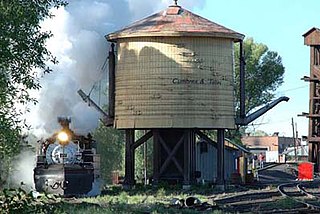 W
WA water stop or water station on a railroad is a place where steam trains stop to replenish water. The stopping of the train itself is also referred to as a "water stop". The term originates from the times of steam engines when large amounts of water were essential. Also known as wood and water stops or coal and water stops, since it was reasonable to replenish engines with fuel as well when adding water to the boiler.